英美教育体系_英文
- 格式:ppt
- 大小:4.40 MB
- 文档页数:30
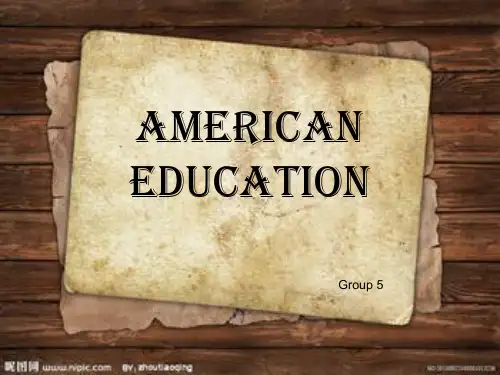
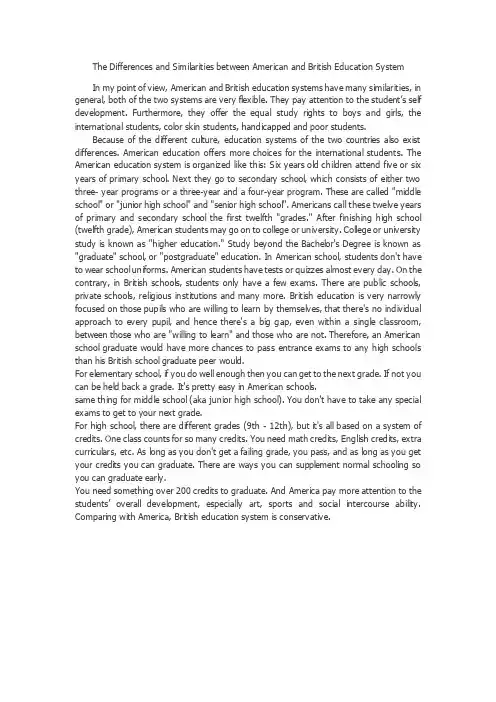
The Differences and Similarities between American and British Education SystemIn my point of view, American and British education systems have many similarities, in general, both of the two systems are very flexible. They pay attention to the student’s self development. Furthermore, they offer the equal study rights to boys and girls, the international students, color skin students, handicapped and poor students.Because of the different culture, education systems of the two countries also exist differences. American education offers more choices for the international students. The American education system is organized like this: Six years old children attend five or six years of primary school. Next they go to secondary school, which consists of either two three- year programs or a three-year and a four-year program. These are called "middle school" or "junior high school" and "senior high school". Americans call these twelve years of primary and secondary school the first twelfth "grades." After finishing high school (twelfth grade), American students may go on to college or university. College or university study is known as "higher education." Study beyond the Bachelor's Degree is known as "graduate" school, or "postgraduate" education. In American school, students don't have to wear school uniforms. American students have tests or quizzes almost every day. On the contrary, in British schools, students only have a few exams. There are public schools, private schools, religious institutions and many more. British education is very narrowly focused on those pupils who are willing to learn by themselves, that there's no individual approach to every pupil, and hence there's a big gap, even within a single classroom, between those who are "willing to learn" and those who are not. Therefore, an American school graduate would have more chances to pass entrance exams to any high schools than his British school graduate peer would.For elementary school, if you do well enough then you can get to the next grade. If not you can be held back a grade. It's pretty easy in American schools.same thing for middle school (aka junior high school). You don't have to take any special exams to get to your next grade.For high school, there are different grades (9th - 12th), but it's all based on a system of credits. One class counts for so many credits. You need math credits, English credits, extra curriculars, etc. As long as you don't get a failing grade, you pass, and as long as you get your credits you can graduate. There are ways you can supplement normal schooling so you can graduate early.You need something over 200 credits to graduate. And America pay more attention to the students’overall development, especially art, sports and social intercourse ability. Comparing with America, British education system is conservative.。
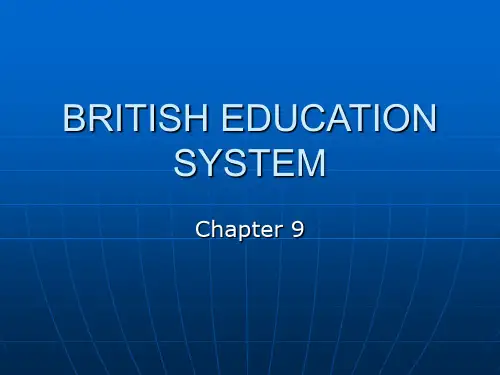
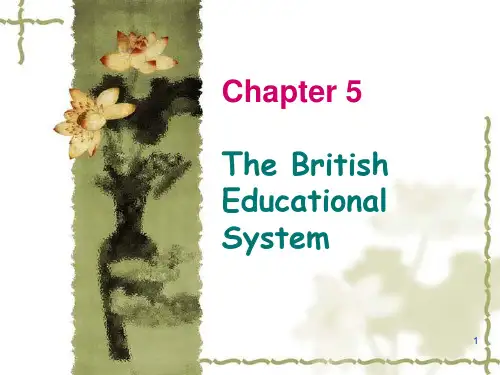

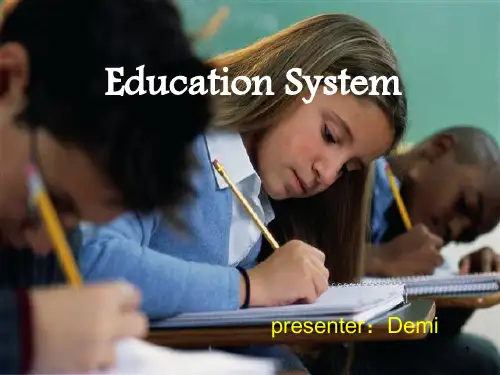
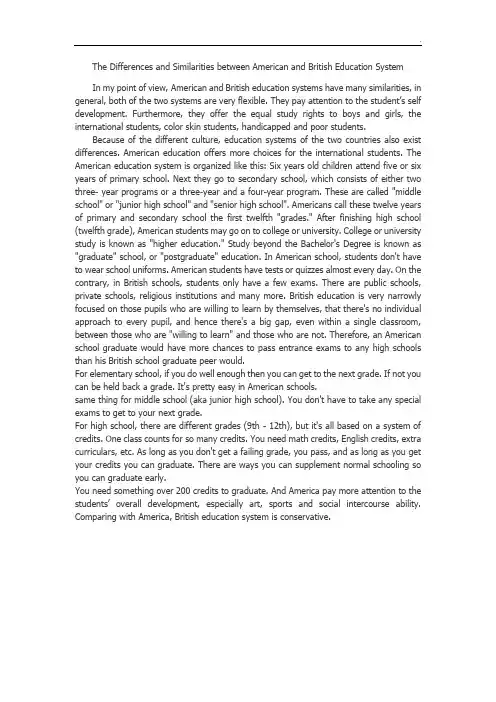
.The Differences and Similarities between American and British Education SystemIn my point of view, American and British education systems have many similarities, in general, both of the two systems are very flexible. They pay attention to the student’s self development. Furthermore, they offer the equal study rights to boys and girls, the international students, color skin students, handicapped and poor students.Because of the different culture, education systems of the two countries also exist differences. American education offers more choices for the international students. The American education system is organized like this: Six years old children attend five or six years of primary school. Next they go to secondary school, which consists of either two three- year programs or a three-year and a four-year program. These are called "middle school" or "junior high school" and "senior high school". Americans call these twelve years of primary and secondary school the first twelfth "grades." After finishing high school (twelfth grade), American students may go on to college or university. College or university study is known as "higher education." Study beyond the Bachelor's Degree is known as "graduate" school, or "postgraduate" education. In American school, students don't have to wear school uniforms. American students have tests or quizzes almost every day. On the contrary, in British schools, students only have a few exams. There are public schools, private schools, religious institutions and many more. British education is very narrowly focused on those pupils who are willing to learn by themselves, that there's no individual approach to every pupil, and hence there's a big gap, even within a single classroom, between those who are "willing to learn" and those who are not. Therefore, an American school graduate would have more chances to pass entrance exams to any high schools than his British school graduate peer would.For elementary school, if you do well enough then you can get to the next grade. If not you can be held back a grade. It's pretty easy in American schools.same thing for middle school (aka junior high school). You don't have to take any special exams to get to your next grade.For high school, there are different grades (9th - 12th), but it's all based on a system of credits. One class counts for so many credits. You need math credits, English credits, extra curriculars, etc. As long as you don't get a failing grade, you pass, and as long as you get your credits you can graduate. There are ways you can supplement normal schooling so you can graduate early.You need something over 200 credits to graduate. And America pay more attention to the students’overall development, especially art, sports and social intercourse ability. Comparing with America, British education system is conservative.。
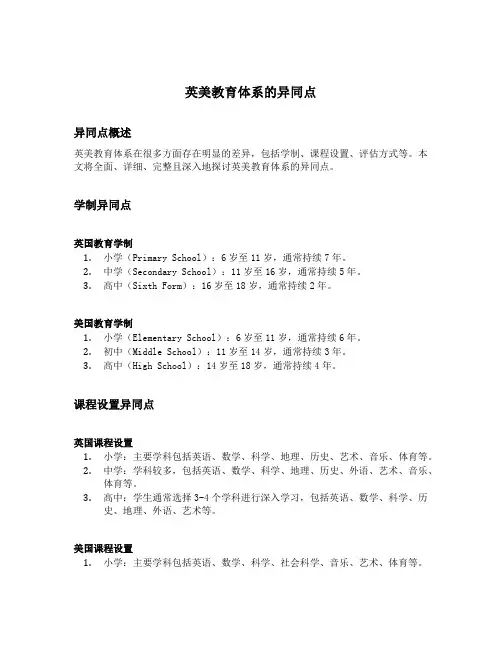
英美教育体系的异同点异同点概述英美教育体系在很多方面存在明显的差异,包括学制、课程设置、评估方式等。
本文将全面、详细、完整且深入地探讨英美教育体系的异同点。
学制异同点英国教育学制1.小学(Primary School):6岁至11岁,通常持续7年。
2.中学(Secondary School):11岁至16岁,通常持续5年。
3.高中(Sixth Form):16岁至18岁,通常持续2年。
美国教育学制1.小学(Elementary School):6岁至11岁,通常持续6年。
2.初中(Middle School):11岁至14岁,通常持续3年。
3.高中(High School):14岁至18岁,通常持续4年。
课程设置异同点英国课程设置1.小学:主要学科包括英语、数学、科学、地理、历史、艺术、音乐、体育等。
2.中学:学科较多,包括英语、数学、科学、地理、历史、外语、艺术、音乐、体育等。
3.高中:学生通常选择3-4个学科进行深入学习,包括英语、数学、科学、历史、地理、外语、艺术等。
美国课程设置1.小学:主要学科包括英语、数学、科学、社会科学、音乐、艺术、体育等。
2.初中和高中:学科较多,包括英语、数学、科学、社会科学、外语、音乐、艺术、体育等。
学生可以选择一些选修课进行个性化学习。
评估方式异同点英国评估方式1.小学:通过内部评估和外部标准化考试进行评估。
2.中学:通过GCSE(普通中等教育证书)考试评估学生的学术水平。
3.高中:通过A-Level(高等科目水平)考试评估学生的学术水平,成绩通常是进入大学的重要依据。
美国评估方式1.学期成绩:学生根据每个学期的表现获得成绩,成绩通常用字母表示。
2.标准化考试:学生需要参加SAT或ACT等标准化考试,成绩通常是进入大学的重要依据之一。
3.高中毕业考试:一些州要求学生通过高中毕业考试才能获得毕业证书。
教育理念异同点英国教育理念1.知识为重:强调学生的学术能力和知识储备,重视学生对学科知识的掌握。
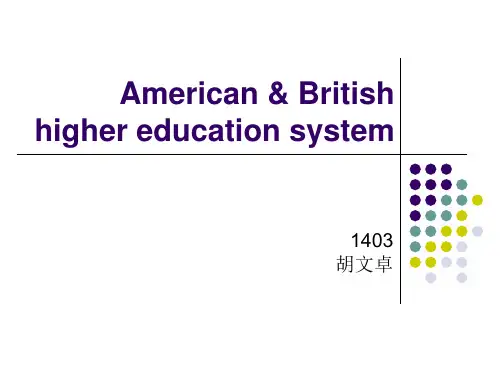

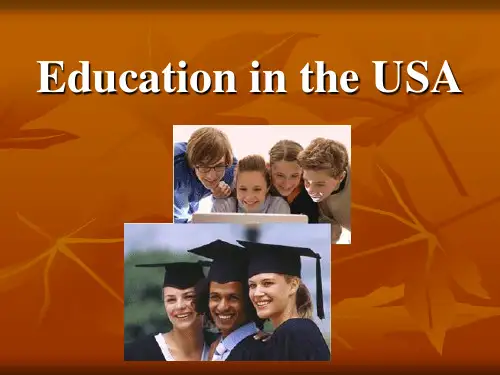
英美教育Education in Britain and The USEducation in Britain and The USIn Britain all children have to go to school between the ages of 5 and 16. In the US children must go to school from the age of 6 to between the ages of 14 and 16, depending on the state they live in.SubjectIn England and Wales the subjects taught in schools are laid down by the National Curriculum(课程), which was introduced in 1988 and sets out(制定) in detail the subjects that children should study and the levels of achievement they should reach by the ages of 7, 11, 14 and 16, when they are tested. The National Curriculum does not apply in Scotland, where each school decides what subjects it will teach.In th e US the subjects taught are decided by national and local governments. Whereas British schools usuall y have prayers(祈祷) and religious(宗教的) instruction, American schools are not allowed to include prayers or to teach particular religious beliefs(信仰).ExaminationsAt 16 students in England and Wales take GCSE examinations. These examinations are taken by students of all levels of ability in any of a range of subjects and may involve a final examination, an assessment(评价) of work done during the two year course, or both of these things. At 18 some students taken A-level examinations, usually in not more than 3 subjects. It is necessary to have A-levels in order to go to a university or polytechnic(综合技术大学).In Scotland students take the SCE examinations. A year later, they can take examinations called HIGHS, after which they can either go straight to a university or spend a further year at school and take the Certificate(证书) of Sixth Year Studies. In Scotland the university system is different to that in England and Wales. Courses usually last four years rather than three and students study a larger number of subjects as part of their degree.In the US school examinations are not as important as they are in Britain. Students in High Schools do have exams at the end of their last two years, but these final exams are considered along with the work that the students have done during the school years.Social Events and Ceremonies(仪式)In American high schools there is a formal ceremony for Graduation (=completion of high school). Students wear a special cap and gown and receive a diploma(文凭) from the head of the school. Students often buy a class ring to ear, and a yearbook, containing pictures of their friends and teachers. There are also special social events at American schools. Sports events are popular, and cheer leaders lead the school in supporting the school team and singing the school song. At the end of their junior year, at age 17 or 18, students held in the evening. The girls wear long evening dresses and the boys wear TUXEDOS.In Britain, there are no formal dances or social occasions(场合) associated(和...有关) with school life. Some schools have SPEECH DAY at the end of the school year when prizes are given to the best students and speeches are made by the head teacher and sometimes an invited guest. However, in many British schools students and teachers organize(组织) informal dances for the older students.。
英国教育体系英国是一个有悠久教育传统的国家。
它的教育体系经过几百年的沿革,相当的完善和复杂,且具有非常大的灵活性。
总体来说分为三个阶段:义务教育(Compulsory Education),延续教育(Further Education)和高等教育(Higher Education)。
义务教育英国的学生从五岁开始接受义务教育,享受全免费的国家福利,学校甚至还提供免费的午餐,所有的家长必须把自己的孩子送到学校读书。
小学教育一般持续到11岁,然后进入中学。
英国的中学不分初中高中,从中一(Form 1)到中五(Form 5)共五年的时间。
英国政府方面为了提高学生们的饭菜质量,决定将烹饪课程从2014年起增加到7岁至14岁儿童的必修课程中。
以达到从小控制学生的饮食进而控制英国的肥胖率。
[延续教育延续教育是英国教育体系中最有特色也最精彩的部分,它是继小学(Primary)中学(Secondary)教育之后的“第三级教育”(Tertiary)。
为进入高等教育或者就业打下基础。
一般来说接受延续教育的学生介于16和18岁之间。
它分为两种体系:学业路线(Academic Route)和职业路线(Vocational Route)。
学业路线着重于培养学术研究方面的人才,职业路线则结合社会各层面的职业需要,培养在各种行业中具有专门技能和知识的人才。
这两种体系在英国受到同等的重视。
学业路线 A-Level的全称是“普通教育高级证书”(General Certificate of Education Advanced Level),是学业路线的重要阶段,它总共有100多个科目,学制一般为两年,专业分科极为细致。
虽然读此类课程的学生年龄在16-18岁之间,但也决不能认为等同于我们中国学生在高中学习的课程。
我们倾向于tend to 把A-Level看作大学的基础课,相当于中国大学本科课程的首两年。
A-Level的选科对学生来说非常重要,一般按照两个原则(专业目标原则、擅长原则)来选科。